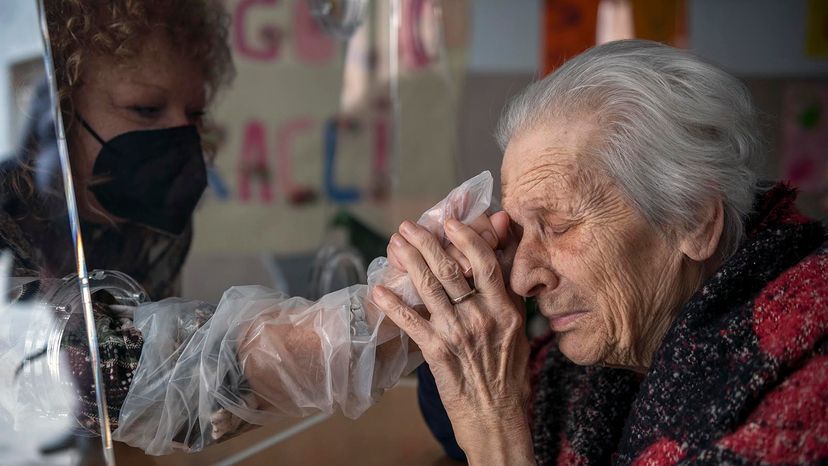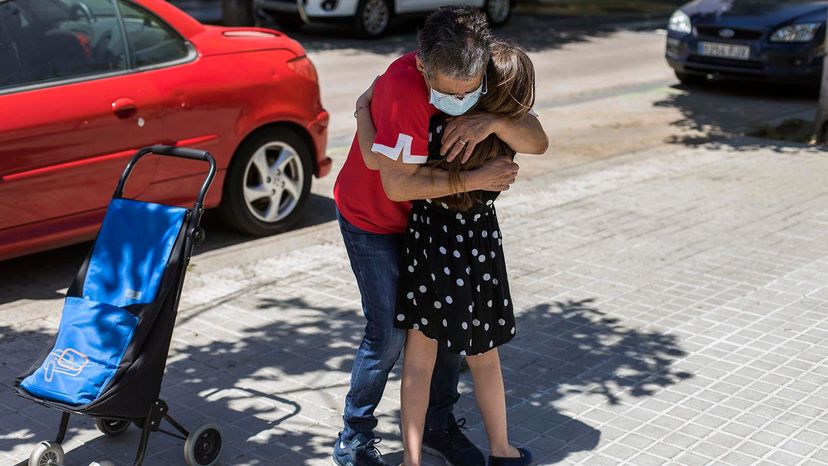 “Anna (right), a resident of the Villa Sacra Famiglia Nursing home in Rome, Italy, hugs her daughter through a plastic screen in the "Hug Room." The nursing home inaugurated the Hug Room in March 2021 so guests and their families could hug each other while still remaining separated and protected from COVID-19. Antonio Masiello/Getty Images
“Anna (right), a resident of the Villa Sacra Famiglia Nursing home in Rome, Italy, hugs her daughter through a plastic screen in the "Hug Room." The nursing home inaugurated the Hug Room in March 2021 so guests and their families could hug each other while still remaining separated and protected from COVID-19. Antonio Masiello/Getty Images
Social distancing, to your everyday homo sapien, is nothing more than a painful oxymoron. You can’t be both social, something that humans inherently are, and distant. You can’t be together and apart.
Still, over the past year-plus, during a pandemic that has tested the limit of our humanness, that’s what’s been expected of us; to not gather, to separate, to keep 6 feet (2 meters) between us yet still carry on as if our entire social existence hasn’t been trashed. It’s practically inhuman.
Is it really a coincidence that the agreed-upon social-distancing buffer is the same depth at which we bury each other?
Social distancing, as smart as it may be to keep the coronavirus at bay, has cost us a lot during the past year or more. Luckily, though, we’re resilient. And as we begin to take the first tentative steps out of this government-approved and medically sound self-exile, we have something that can fix all the stress and loneliness that have piled up during our social distancing.
That’s right, you newly vaccinated, yearning to break free. It’s time, finally, for a great, big hug.
 “In March 2021, the Centers for Disease Control updated its recommendations for fully vaccinated adults which now means grandparents can visit and hug their unvaccinated grandchildren without wearing masks or physical distancing, as long as none of the unvaccinated family members are at risk of severe COVID-19.SOPA Images/SOPA Images/LightRocket via Getty Images
“In March 2021, the Centers for Disease Control updated its recommendations for fully vaccinated adults which now means grandparents can visit and hug their unvaccinated grandchildren without wearing masks or physical distancing, as long as none of the unvaccinated family members are at risk of severe COVID-19.SOPA Images/SOPA Images/LightRocket via Getty Images
The Power of Hugging
Like the rest of us, scientists have long suspected the healing capacity of a good hug. Unlike the rest of us, they’ve gone about trying to prove it.
"There’s a lot that we still need to learn, and there’s a lot we don’t know," says Michael Murphy, a research professor in the department of psychological sciences at Texas Tech University. "What seems to be emerging is that hugs, as well as other forms of affectionate touch, are really powerful ways of reminding people that they’re cared about, they belong, that they have someone in their corner.
"We expect touch. When we’re born, we’re placed in our mother’s arms almost immediately. In that first year of our life, we spend a lot of time being held by other people. And as we grow up, we seek out hugs and touch and cuddling as a way of connection. I think what has been lost in this past year are these really easy opportunities to be reminded of connection."
While he was at Carnegie Mellon, Murphy was the lead author of a hug-centered 2018 article in the scientific journal PLOS One. In a series of interviews with 404 adults over a two-week period, the researchers found, in the science-speak of the paper’s title, that "Receiving a hug is associated with the attenuation of negative mood that occurs on days with interpersonal conflict." That is to say, generally, hugs help to blunt the negative impacts that personal conflicts may cause in our daily lives.
Other papers have found similarly that hugs aren’t just reserved for simple social greetings. Hugs and other forms of physical touch can really change a person’s moods. A 2006 brain-wave study in which 16 married women were threatened with an electrical shock showed that simply holding hands with their husbands helped calm the brain’s reactions to the possible threat. Further, holding hands with their husbands in what was considered a higher-quality marriage lessened the brain’s threat response even more.
 “Surab Nasrallah (right) hugs executive director Margarita Kechichian before visiting her father on the first day of in-room family member visits at the Ararat Nursing Facility in the Mission Hills March 24, 2021 in Los Angeles. Mario Tama/Getty Images
“Surab Nasrallah (right) hugs executive director Margarita Kechichian before visiting her father on the first day of in-room family member visits at the Ararat Nursing Facility in the Mission Hills March 24, 2021 in Los Angeles. Mario Tama/Getty Images
What Happens When We Hug?
Some of the body’s physiological reaction to hugs may center on oxytocin, a hormone normally associated with childbirth. Oxytocin, among other roles, stimulates uterine muscles to contract to begin labor. In a 2014 study, it also was found to show a link between hugging and lower blood pressure.
Oxytocin is known as the "cuddle hormone," to the non-scientific among us.
Hugs and other forms of personal touch also may trigger our endogenous opioid system, which can release all sorts of feel-good and stress-relieving chemicals
"Laboratory studies … suggest that things like hugs help us feel safer and more cared-for, and feeling safer and more cared-for in turn makes us less sensitive to physical pain and less reactive when we’re faced with potentially threatening experiences," Murphy says. "This lab work has shown that hugs and other touch behaviors promote a number of beneficial processes. Touch promotes less cardiovascular reactivity related to stress. The more stress we have, the more our heart rate goes up, our blood pressure goes up; we mount the fight or flight response. And receiving warm, affectionate touch can dampen that."
Researchers still have plenty of questions about how hugs work: What happens when we go without? Are all hugs alike? How do different cultures around the world view the worth of hugging? What about people who don’t like to be hugged? How long is too long for a hug?
The answers may not be evident yet. But for now, getting back to a partial side hug, an enveloping wraparound, a hello hug, a goodbye hug, an arm around the shoulder, a squeeze around the waist, or a big, swallow-you-up-or-be-swallowed bear hug will be plenty for the hug-starved.
"I’ve certainly heard anecdotally from family members and friends who have been fully vaccinated, of them lingering in their hugs with their fellow friends and family members who are also vaccinated. Just sort of lounging in that feeling of being able to do that again," Murphy says. "I think there’s a lot of thirst there."
Now That’s Interesting
One 2011 study from the University of Dundee in Scotland concluded that most (but certainly not all) hugs last about three seconds. Which happens to be about the same time, the researchers found, as a French two-kiss greeting, a wave goodbye or hello, and a breath (in and out). The study bolstered a hypothesis that humans live in the present in three-second bursts. The researchers timed hugging among athletes at the 2008 Beijing Olympics













































